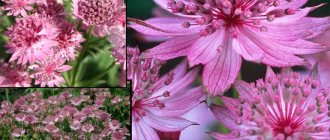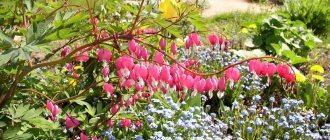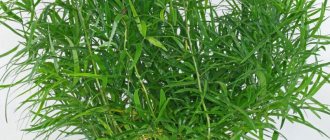A plant such as Campsis, also called begonia, is a deciduous woody vine that is directly related to the begoniaceae family. This is a very large plant that loves warmth and is decorated with large, richly colored flowers. Kampsis is translated from Greek as “to bend, twist, bend.” There are gardeners who believe that campsis and tecomaria (tecoma) are the same plant, but this is a mistake. Such plants are considered representatives of the same family, but they belong to different genera. This genus includes only a couple of species, one of which has been grown in European parks since the 17th century.
Features of Kampsis
This vine is often used for vertical gardening. The fact is that it is able to cling and hold on to support with its aerial roots. The odd-pinnate complex leaf plates include from 7 to 11 leaflets, which have a serrated edge. These leaves look very impressive. The tubular flowers are large in size and have no scent at all. They are part of short paniculate inflorescences located at the ends of the stems, while such flowers reach 9 centimeters in length and their diameter is 5 centimeters. The color of the flowers depends on the variety and can be crimson, pink, orange-red or golden-red.
The plant begins to bloom in June and ends in September. This vine is considered a honey plant, and it is capable of gathering around itself not only bees, but also ants, wasps and flies. The fruit is a leathery, elongated pod that reaches a length of 8 to 10 centimeters. Such a pod consists of 2 valves, while inside it there are many membranous seeds with wings. The ripe fruit cracks, and many seeds fly out of it, which can fly quite far. But you should know that not all campsis produce seeds. It is believed that this requires that there be a vine of a different clone in close proximity.
My malicious Campsis vine is a real aggressor
general information
In nature, Kampsis or Tecoma grows mainly in North America, and can stretch its shoots up to 15 m. In fact, it is a decorative flowering vine, but some varieties can be formed as standard trees.
Campsis is a large and tall plant with a powerful root system. Flexible shoots become woody with age and become covered with aerial roots. The leaves have a curious serrated edge, and the flowers are red or orange. Campsis blooms in June and continues to bloom until frost.
Photo: zen.yandex.ru
Planting Kampsis in open ground
Landing in the middle lane
In general, Kampsis is a fairly cold-resistant plant that can withstand short-term temperature drops to minus 20 degrees. However, planting such a vine directly into open soil in the middle zone is recommended only from mid-May. It is necessary to plant such a vine in the southern or southeastern part of the garden, and the selected area must be protected from drafts and strong winds. However, try to ensure that the campsis grows at a sufficient distance from windows, the fact is that during flowering it attracts a huge number of insects. The composition of the soil can be absolutely anything; it can be grown even on an area with limestone soil, but the soil must contain a large amount of minerals and trace elements. The planting hole for the plant should be prepared in the autumn, and its dimensions should be 40x50x50 centimeters.
How to plant
If you want the vine to bloom at the age of two or three, then plant it in open soil, in which case you need a rooted cutting, which must be taken from a profusely flowering specimen.
When preparing a planting hole, you need to remove the top layer of soil and combine it with 0.5 kg of complete mineral fertilizer and 5 kg of compost. The resulting earth mixture should be poured onto the bottom of the hole. After this, you need to place the root system of the plant in the hole and straighten them. Then you need to pour the remaining soil mixture into the hole in parts. The liana should not be buried; it should be planted at the same depth that it grew before. After planting, the surface of the tree trunk circle must be thoroughly compacted, and then the campsis should be watered. After the liquid is completely absorbed into the ground, it is necessary to sprinkle its surface with a layer of mulch (peat or compost). Such a plant requires support because it is a vine. After the support is dug in, the seedling is tied up. Remember that such a vine is quite aggressive, and to prevent it from growing too much, you need to dig slate or metal sheets around the tree trunk, and they need to be buried approximately 0.8 meters.
Reviews from gardeners about culture
My Kampsis has been growing for several years. The liana has grown up to 7 meters. In winter, thin branches freeze out, but quickly recover. And our frosts are -30ºС. In the garden, where I buried the root out of ignorance of its regenerative abilities, I have been trying to lime it for five years now and have not succeeded. She didn’t cover it with anything.
THNATA
https://www.forumhouse.ru/threads/78237/
It is easy to propagate like willow. In February, cut the cuttings and place them in a container with water. It will give roots by spring. Campsis needs to be covered in the first years, but then it is more hardy. But, of course, it is not for the Moscow region.
Verachet
https://www.forumhouse.ru/threads/78237/
Campsis is good, especially old specimens with a woody, twisted trunk, like in the jungle. I couldn’t resist either: at the beginning of last summer I planted a rooted cutting, now I’m calm about it, after all, I live in the south. And his flowers contain such sweet nectar that ants move in herds, but I still want such a handsome man to grow up with me.
Pelargoshka
https://www.forumhouse.ru/threads/78237/
I consider it my duty to inform those interested that I have found five places in the glorious city of Voronezh where campsis grow wildly without any shelter and bloom no less wildly. Some examples reached the level of the second floor and above. Really, I didn’t expect that the southern liana could grow in Voronezh without any problems. To be fair, it must be said that all these campsis grow within the city, and this, as you know, gives a significant head start in terms of wintering.
Milyaev
https://forum.tvoysad.ru/viewtopic.php?t=9650&start=15
Campsis is handsome! I look at him and remember my vacation at sea! Undemanding and self-sufficient. Highly recommend! An excellent option for covering a fence.
Larisa Litke
https://ok.ru/magazinros/topic/63758010054085
I also have such a plant in my dacha. Moreover, over the course of 10 years, they have been divorced in countless quantities. For me it grows as a large vine. Blooms all summer.
Perl
https://frauflora.ru/viewtopic.php?t=4149
My campsis grows a meter from the wall of the house. I “took him” to the wall at a height of 2 meters. Before this, I methodically destroyed the side shoots. Now the trunk is bare 2 meters from the ground, and all the greenery is higher. There are a lot of shoots climbing up, sometimes popping up ten meters from the main plant. I destroy it periodically. Lots of flower debris. And one more nuance - Kampsis attracts a lot of bees. Plus - very beautiful!
Brawler
https://forum-flower.ru/showthread.php?t=9410
Even a novice gardener can cope with growing campsis. The plant is problem-free and it is extremely difficult to destroy it. A minimum of time and effort is spent on caring for the vine, for which it “thanks” the owner with bright and long-lasting flowering. The only drawback of Kampsis that prevents its spread throughout Russia is its low frost resistance.
- Author: Maria Sukhorukikh
Rate this article:
- 5
- 4
- 3
- 2
- 1
(0 votes, average: 0 out of 5)
Share with your friends!
Growing Kampsis in the garden
Do not be afraid that this plant is exotic. The fact is that it is relatively unpretentious and not too demanding to care for. You need to care for such a vine in almost the same way as other plants. It should be watered in a timely manner, the top layer of soil should be loosened, weeded on time, and fed. You should also protect the plant from harmful insects and diseases, and be sure to carry out pruning on time. Particular attention should be paid to watering such a plant, because it reacts extremely negatively to both stagnation of fluid in the root system and drought. Remember that while the soil is moist, it will be much easier to remove all weeds and loosen its top layer. Despite the fact that the plant is quite resistant to drought, it should be watered in a timely manner, because otherwise its decorative value will be significantly reduced. In order to reduce the number of waterings, it is recommended to plant several compact low-growing shrubs on the tree trunk area, and the care rules for all these plants, including the vine, should be the same.
Campsis does not need to be fed. However, if you add fertilizer containing phosphorus and nitrogen to the soil, it will bloom very luxuriantly throughout the season.
Trimming
Such a plant needs systematic pruning. The formation of the bush should begin after planting. To do this, you need to cut off all the stems so that the remaining length is 15 centimeters. After the shoots begin to grow, you should select 4 or 5 of the most powerful ones, and cut off all the remaining ones. As the stems grow, they need to be directed along the support, and if such a need arises, it will be possible to tie the shoot to it. The liana will be considered formed only when the length of the skeletal branches is equal to 400 centimeters. And this will happen after approximately 2 or 3 years. The side stems need to be trimmed every year to two or three buds, while those that are weakened, dried out, affected by disease, or growing in the wrong direction must be cut off. If any of the skeletal branches was severely injured, then it must be cut off completely. After some time, replacement branches will appear in its place, from which one will need to select the most powerful one, and the remaining ones will need to be cut off. If necessary, you can do anti-aging pruning; for this you need to cut off all the branches at a height of 0.3 meters. It is recommended to carry out the pruning procedure in early spring, when the buds are still dormant.
During flowering, you need to promptly pick off flowers that have begun to fade, as well as trim those branches that have faded by 3 or 4 eyes. In this case, the plant will bloom for a very long time and look very impressive.
Why don't flowers appear on Kampsis?
Often, gardeners cannot wait for the Kampsis, which was grown from seed, to begin flowering. The fact is that in this case the vine will be able to bloom for the first time only 4–6 years after the seedling appears. If you grow such a vine from a cutting, it will bloom in the third year. This phenomenon can also be caused by late frosts in spring, harmful insects or diseases, as well as drafts. If you grow such a vine in a region with a relatively cold climate, then you may not even wait for it to bloom.
Harmful insects and diseases
This plant is highly resistant to diseases and harmful insects. However, if water stagnates in the roots, then rot may appear on them, and during a dry, hot period, aphids may settle on the vine. To destroy aphids, you should treat the specimen with a solution of tar soap (10 grams of substance per bucket of water).
Pests
Infestation of Campsis by insects becomes a serious problem due to its size. Therefore, it is important to treat with insecticides at the first signs of infestation.
Campsis is not very capricious, but still requires some attention. Thanks to its pliability, the plant is easy to use in landscape design, both complementing the main composition and building one around this brightly flowering vine.
Reproduction of Kampsis
To propagate such a plant, seeds, layering, root shoots, as well as lignified or green cuttings are used.
Growing from seeds
This method of propagating Kampsis as a generative (seed) method has two major drawbacks. The first drawback is that vines grown in this way are only in rare cases able to inherit the characteristics of the mother plant, and the second is that such campsis begins to bloom several years later than the one that was grown vegetatively. The advantage of this method is that it is the simplest. Seeds do not need to be stratified or specially prepared before sowing, and they can also be stored at room temperature. Seeds are sown in the spring, using a permeable neutral substrate. You only need to bury the seeds half a centimeter into the soil, then put the container in a warm place (25 degrees). The first seedlings will appear after 4 weeks. After the seedlings have formed 3 pairs of true leaves, they will need to be planted in open ground in a permanent place.
Cuttings
Green cuttings should be prepared in June or July, with only the middle part of the stem taken. All leaves should be removed from them except the top 2-3, which will need to be shortened by 2/3. You need to make a bed in a shaded place and plant the cutting there at an angle of 45 degrees. It should be taken into account that the soil must be loose and fertile. The planted cuttings need to be watered, and the surface of the bed should be covered with a layer of mulch. On average, every ninth cutting out of 10 takes root.
You can also use lignified cuttings for propagation. They should be prepared at the beginning of the spring, using lignified one-year-old shoots. Cuttings are planted at an angle in a permanent place, because on average 10 cuttings out of 10 take root.
Kampsis. Growing from cuttings. Reproduction of Kampsis. Lianas. Landscape design
How to propagate by root shoots
If the conditions for growing such a vine are favorable, then it will develop dense root shoots. Dig up the root shoot with part of the root, and then plant it in a place where it will grow permanently. This procedure should be carried out at the beginning of spring or after all the leaves have fallen off.
Reproduction by layering
In spring, you should choose the stem that grows near the soil surface. It is bent to the ground and fixed in this position. During the growing season, it is necessary to ensure that the soil around the cuttings is constantly loose and moist. With the onset of the next spring, the rooted cuttings are separated and planted in a permanent place. This plant exhibits fairly rapid growth and development.
Bacterial rot
Signs of infection: blackening of the petiole, leaves become soft, roots become loose.
How to treat: remove all affected areas, treat the plant with a fungicide.
After flowering
This vine is quite frost-resistant. So, she can easily tolerate a drop in temperature to minus 20 degrees, but it should be short-term. If the winter is long and frosty, then the plant will need shelter. In this regard, experts advise making removable supports for the campsis so that they can be removed in the fall and reinstalled with the onset of spring. For wintering, such a plant is covered in almost the same way as grapes. The stems must be removed from the support and placed on the surface of the soil. Then they need to be covered with a layer of dried leaves, sawdust or spruce branches. A film must be laid on this layer, which is again covered with spruce branches.
Rules of care
We can say that Kampsis resembles a weed. And all thanks to its rapid growth and vitality. However, in order to get abundant and long-lasting flowering, you must carefully follow the rules for planting and caring for campsis in the Moscow region and other regions of Russia:
- Lighting. For proper development, bud formation and enhanced growth, Kampsis needs good lighting. Therefore, select open areas for planting. There is no need to be afraid - the sun's rays will not burn the foliage even in extreme heat.
- Temperature conditions. Naturally, since the plant is thermophilic, then the temperature should be quite high, as in the southern regions. In areas of northern latitudes, development activity is much lower. In addition, the plant needs to be protected from drafts and covered for the winter.
- Watering. During periods of extreme heat, as well as when buds open, the plant needs abundant watering. However, a slight drought will not harm it. But he doesn’t like “wet feet,” so avoid stagnant water in the soil.
- Feeding. If the plant is planted in a fertile substrate, fertilizing is not necessary. If there are not enough useful and nutritional components, fertilizing should be done in the form of nitrogen-phosphorus complexes.
- Wintering. Campsis needs to be prepared for winter - its roots are covered with fallen leaves, spruce branches, and sawdust. It is advisable to remove the vine from the supports, place it on the ground and also cover it. If this cannot be done, the vines are simply insulated by wrapping them with plastic film directly on the support. But in Belarus, caring for campsis does not include shelter for the winter.
- Trimming. The vine should be pruned throughout the year. First, pruning is done in the spring to remove frozen and old branches and stimulate the growth of new ones. Repeated pruning is carried out in the fall to shorten and shape the overgrown vine.
Spring pruning of Kampsis - video
Types and varieties of Kampsis with photos and names
This genus is represented by only two species. Campsis grandiflora is native to China and Japan, and Campsis rooting is North America. Thanks to the work of breeders, a third type of campsis, called hybrid, was born.
Rooting Campsis (Campsis radicans), or Rooting Bignonia (Bignonia radicans)
This vine can reach a height of 15 meters, and in order to cling to support, it uses many aerial roots. The odd-pinnate leaf blades reach 20 centimeters in length and contain from 9 to 11 leaflets. The front side of the leaves is bare and painted a rich green color, and the back side is pale green, and on its surface there is pubescence, which can be located throughout the entire leaf blade or only on the veins. The length of the funnel-tubular flowers is about 9 centimeters, and their diameter is 5 centimeters. The corolla is deep orange, and the limb is fiery red. There are from 10 to 15 flowers in the apical racemose inflorescences. The flowering of this vine is quite long due to the fact that the opening of flowers occurs gradually. And flowering for this species begins in the second half of the summer. The fruits are pod-shaped flat capsules, 5–12 centimeters long. Cultivated since 1640. Decorative forms:
- Gorgeous. This plant is weakly climbing. Outwardly, it looks like a shrub with thin and long stems. The complex leaf blades include small oval-shaped leaves. The flowers are orange-red.
- Golden. The flowers are yellow.
- Early. Large flowers are scarlet colored. Flowering begins 4 weeks earlier than the base species.
- Dark purple. Large dark scarlet flowers have a purple tint.
Large-flowered Campsis (Campsis grandiflora), or Chinese Campsis, or Chinese Bignonia (Bignonia grandiflora)
It does not have aerial roots, like the previous species. Such a vine clings to the support with the ends of its stems. This plant has a relatively short height, and most often looks more like a low shrub. The imparipinnate leaf plates include from 7 to 9 leaflets, having a length of about 6 centimeters. There is no pubescence on their underside surface. The orange-red funnel-tubular flowers are larger in size compared to the previous species, so they can reach 8 centimeters in diameter. From the moment the seedling appears until the first flowering, 3 years pass. The fruit is a pod-shaped capsule, reaching a length of 15 to 20 centimeters. This species is less frost-resistant in comparison with the previous one, but it is much more beautiful. The species has a decorative form - Campsis Thunberg. Its orange flowers have a short tube and the same lobes. Cultivated since 1800
Description of the plant
The flowers of the vine are large, bright, and attract attention. A plant up to 3 m long looks wonderful as a wall decoration or gazebo.
- Gardeners grow this vine as living fences or trellises.
- When pruning hybrid varieties, a compact flowering bush is obtained.
- Hybrid species are grown on balconies and loggias.
The plant is native to Chinese and North American regions. This vine appeared in Europe back in the 17th century. Used to decorate castles and temples. A vine planted near the walls grows numerous shoots, which are decorated with large multi-colored flowers.
This deciduous plant spreads quickly. The roots are powerful, spreading not only deep, but also wide. The rhizome produces a lot of shoots per season. Young shoots with smooth green bark often emerge to the surface several meters from the parent bush.
With age, the shoots begin to become lignified, becoming similar to a tree trunk with a reddish color. Between the nodes on the shoots there are aerial roots. Between them, opposite leaves grow on long petioles. Up to 10 leaves grow on one petiole. The leaves have jagged edges, the lower part of the leaf is slightly pubescent, but the upper part has a glossy shell.
Liana blooms in summer. Many inflorescences are produced over the summer. On one peduncle there are 3–8 tubular flowers up to 8 cm in diameter. At the base of the flower, the petals have grown together into a corolla. The color of the petals ranges from pink to orange.
After flowering, fruit ripening begins. The fruit is in the form of a pod up to 10 cm long. It is bivalve, inside there are brown seeds that are slightly pubescent. When the pod ripens, the valves open and the seeds fall to the ground. The wind carries the seeds over long distances.











